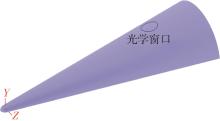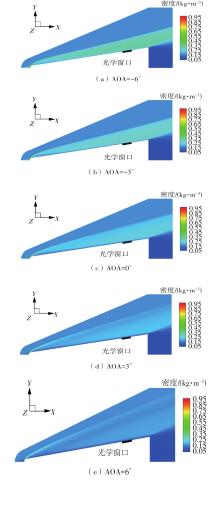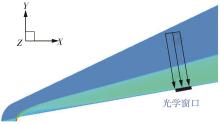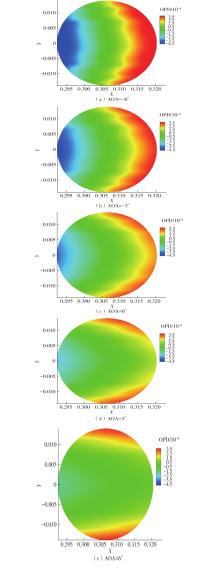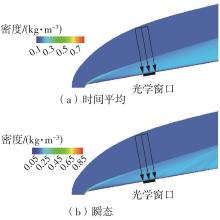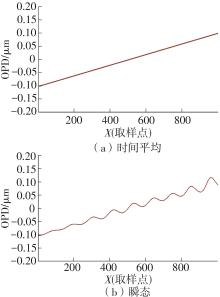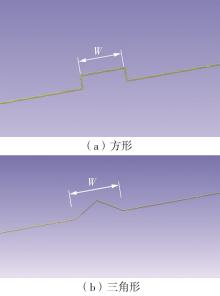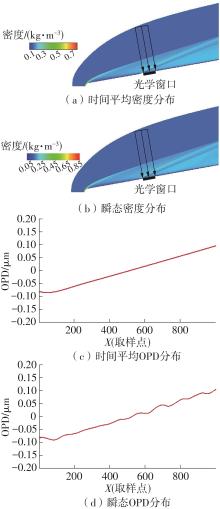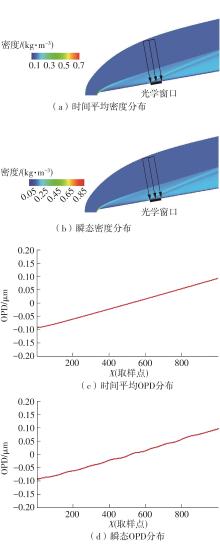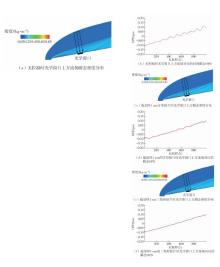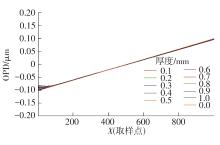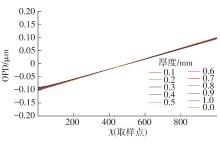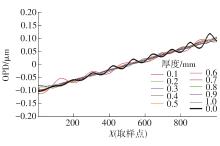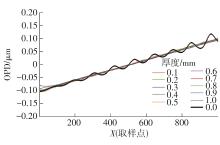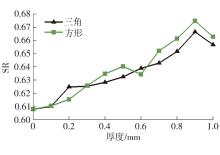Journal of South China University of Technology(Natural Science Edition) ›› 2023, Vol. 51 ›› Issue (2): 137-146.doi: 10.12141/j.issn.1000-565X.220390
Special Issue: 2023年物理学
• Physics • Previous Articles
On Aero-optical Effect and Control of Supersonic Boundary Layer
TIAN Lifeng GUO Meiqi DING Hao HUANG Kaiyou JIANG Ting
- School of Aeronautics and astronautics,Sun Yat-Sen University,Shenzhen 518107,Guangdong,China
-
Received:2022-06-21Online:2023-02-25Published:2023-02-01 -
Contact:田立丰(1979-),男,博士,副教授,主要从事实验空气动力学、气动光学研究。 E-mail:tianlf5@mail.sysu.edu.cn -
About author:田立丰(1979-),男,博士,副教授,主要从事实验空气动力学、气动光学研究。 -
Supported by:the Key Laboratory Fund for Equipment Preliminary Research(6142703180211)
CLC Number:
Cite this article
TIAN Lifeng, GUO Meiqi, DING Hao, et al. On Aero-optical Effect and Control of Supersonic Boundary Layer[J]. Journal of South China University of Technology(Natural Science Edition), 2023, 51(2): 137-146.
share this article
| 1 | 任晓坜 .大口径光学系统气动光学效应及抑制技术研究[D].北京:中国科学院大学(中国科学院光电技术研究所),2019. |
| 2 | 殷兴良 .气动光学原理[M].北京:中国宇航出版社,2003. |
| 3 | REN W, LIU H .Effects of compressibility and Knudsen number on the aero optics in hypersonic flow fields [J].J Shanghai Jiaotong University,2016,21(3):270-279. |
| 4 | MANI Ali .Optical distortions by compressible turbulence [D].United States:Stanford University,2009. |
| 5 | 韩志平,殷兴良 .气动光学效应中调制传递函数的计算方法[J].现代防御技术,2000,28(6):30-35. |
| HAN Zhiping, YIN Xingliang .Calculation method of modulation transfer function in aero-optical effect [J].Modern Defense Technology,2000,28(6):30-35. | |
| 6 | 张丽琴,费锦东 .气动光学效应光电校正方法研究 [J].红外与激光工程,2004,33(6):580-583. |
| ZHANG Liqin, FEI Jindong .Study on photoelectric correction method of aerooptics effect [J].Infrared and Laser Engineering,2004,33(6):580-583. | |
| 7 | 黄战华,程红飞,蔡怀宇,等 .变折射率介质中光线追迹通用算法的研究[J].光学学报,2005,25(5):589-592. |
| HUANG Zhanhua, CHENG Hongfei, CAI Huaiyu,et al .Research on general algorithm for ray tracing in variable refractive index media [J].Acta Optica Sinica,2005,25(5):589-592. | |
| 8 | CHRISTOPHE B, GENEVIÈVE C B .Turbulence [M].New York,Dordrecht London:Springer Cham Heidelberg,2015. |
| 9 | TSINOBER A .An informal introduction to turbulence [M].Israel:Kluwer Academic Publishers,2001. |
| 10 | TRUMAN C R .The influence of turbulent structure on optical phase distortion through turbulent shear flows [C]∥Annual Interceptor Technology Conference. [2012-08-17].. |
| 11 | 解少飞,杨武兵,沈清 .高超声速边界层转捩机理及应用的若干进展回顾[J].航空学报,2015,36(3):714-723. |
| XIE Shao-fei, YANG Wu-bing, SHEN Qing .Review of some advances in hypersonic boundary layer transition mechanism and applications [J].Acta Aeronautica et Astronautica Sinica,2015,36(3):714-723. | |
| 12 | MASLOV A A, SHIPYLUK A N, BOUNTIN D A,et al .Mach 6 boundary-layer stability experiments on sharp and blunt cones [J].Journal of Spacecraft and Rockets,2006,43(1):71-76. |
| 13 | 周恒,赵耕夫 .流动稳定性[M].北京:国防工业出版社,2004. |
| 14 | GAD-EL-HAK M, POLLARD A, BONNET J P .Flow control:fundamentals and practices[M].Berlin:Springer,1998. |
| 15 | 曹伟,周恒 .二维超音速混合层增强混合的研究[J].中国科学A辑:数学 物理学 天文学,2002,32(2):150-157. |
| CAO Wei, ZHOU Heng .Study on enhanced mixing of two-dimensional supersonic mixing layer[J].Science in China Series A:Mathematics,Physics and Astronomy,2002,32(2):150-157. | |
| 16 | 孙明波,王振国,梁剑寒 .入流周期性温度激励下的二维超声速混合层混合增强[J].宇航学报,2008,29(2):444-448. |
| SUN Mingbo, WANG Zhenguo, LIANG Jianhan .Mixing enhancement of two-dimensional supersonic mixing layer under inflow periodic temperature excitation[J].Journal of Astronautics,2008,29(2):444-448. | |
| 17 | WANG L, LUO Z B, XIA Z X,et al .Review of actuators for high speed active flow control[J].Science China Technological Sciences,2012,55(8):2225-2240. |
| 18 | SCHREYER A M, SAHOO D, WILLIANMS O J,et al .Influence of a micro-ramp array on a hypersonic shock-wave/turbulent boundary-layer interaction[J].AIAA Journal,2021,59(5):1924-1939. |
| 19 | 赵延辉,梁剑寒,赵玉新,等 .基于微型涡流发生器的横向射流被动控制研究[J].推进技术,2016,37(5):801-806. |
| ZHAO Yanhui, LIANG Jianhan, ZHAO Yuxin,et al .Research on passive control of transverse jet flow based on micro vortex generator [J].Journal of Propulsion Technology,2016,37(5):801-806. | |
| 20 | VERMA S B, CHIDAMBARANATHAN M .Transition control of Mach to regular reflection induced interaction using an array of micro ramp vane-type vortex generators[J].Physics of Fluids,2015,27(10):107102. |
| 21 | 江贤洋,李存标 .高超声速边界层感受性研究综述[J].实验流体力学,2017,31(2):1-11. |
| JIANG Xianyang, LI Cunbiao .A review of hypersonic boundary layer sensitivity [J].Journal of Experimental Fluid Mechanics,2017,31(2):1-11. | |
| 22 | 苏彩虹 .高超声速边界层转捩预测中的关键科学问题:感受性、扰动演化及转捩判据研究进展[J].空气动力学学报,2020,38(2):355-367. |
| SU Caihong .Key scientific Issues in Hypersonic boundary layer transition prediction:advances in sensitivity,disturbance evolution and transition criteria [J].Journal of Aerodynamics,2020,38(2):355-367. | |
| 23 | 刘向宏,赖光伟,吴杰 .高超声速边界层转捩实验综述[J].空气动力学学报,2018,36(2):196-212. |
| LIU Xianghong, LAI Guangwei, WU Jie .Review of hypersonic boundary layer transition experiments [J].Journal of Aerodynamics,2018,36(2):196-212. | |
| 24 | 段毅,姚世勇,李思怡,等 .高超声速边界层转捩的若干问题及工程应用研究进展综述[J].空气动力学学报,2020,38(2):391-403. |
| DUAN Yi, YAO Shiyong, LI Siyi,et al .Review on some problems and engineering applications of hypersonic boundary layer transition [J].Chinese Journal of Aerodynamics,2020,38(2):391-403. | |
| 25 | 黄章峰,万兵兵,段茂昌 .高超声速流动稳定性及转捩工程应用若干研究进展[J].空气动力学学报,2020,38(2):368-378. |
| HUANG Zhangfeng, WAN Bingbing, DUAN Maochang .Research progress on hypersonic flow stability and transition engineering applications [J].Chinese Journal of Aerodynamics,2020,38(2):368-378. | |
| 26 | 罗纪生 .高超声速边界层的转捩及预测[J].航空学报,2015,36(1):357-372. |
| LUO Jisheng .Transition and prediction of hypersonic boundary layer [J].Acta Aeronautica et Astronautica Sinica,2015,36(1):357-372. | |
| 27 | 杨武兵,沈清,朱德华,等 .高超声速边界层转捩研究现状与趋势[J].空气动力学学报,2018,36(2):183-195. |
| YANG Wubing, SHEN Qing, ZHU Dehua,et al .Research status and trends of hypersonic boundary layer transition [J].Chinese Journal of Aerodynamics,2018,36(2):183-195. | |
| 28 | 陈坚强,涂国华,张毅锋,等 .高超声速边界层转捩研究现状与发展 趋势[J].空气动力学学报,2017,35(3):311-337. |
| CHEN Jianqiang, TU Guohua, ZHANG Yifeng,et al .Research status and development trend of hypersonic boundary layer transition [J].Chinese Journal of Aerodynamics,2017,35(3):311-337. | |
| 29 | 易仕和,何霖,赵玉新,等 .基于NPLS技术的超声速混合层流动控制实验研究[J].中国科学(G辑:物理学 力学 天文学),2009,39(11):1640-1645. |
| YI Shihe, HE Lin, ZHAO Yuxin,et al .Experimental study on flow control of supersonic mixed layer based on NPLS technology [J].Science in China (Series G:Physics,Mechanics and Astronomy),2009,39(11):1640-1645. |
| [1] | YU Mingquan, ZHAO Jiyun, MAN Jiaxiang, et al.. Study of Distribution Structure for High Water-Based Hydraulic Motor [J]. Journal of South China University of Technology(Natural Science Edition), 2023, 51(9): 19-29. |
| [2] | LU Zhimin, LI Bohang, TANG Wen, et al. Optimization Simulation of Ammonia Injection in SCR DeNO x System of Coal-Fired Power Plant [J]. Journal of South China University of Technology(Natural Science Edition), 2023, 51(8): 62-70. |
| [3] | LIU Dingping, ZHANG Xiangyang, CHEN Aihua, et al. Numerical Analysis of Performance of Cyclone-Tube Demister Based on Orthogonal Design [J]. Journal of South China University of Technology(Natural Science Edition), 2023, 51(6): 89-96. |
| [4] | MA Xiangjun, WANG Zhen, YAO Zhiqiang, et al. Numerical Simulation on Melt Flow Characteristics of UHMWPE in Eccentric Rotor Extruder [J]. Journal of South China University of Technology(Natural Science Edition), 2023, 51(5): 114-121. |
| [5] | DAI Gonglian, CHEN Kun, GE Hao, et al. Research on Numerical Simulation of Rail Non-contact Nondestructive Testing Technology [J]. Journal of South China University of Technology(Natural Science Edition), 2023, 51(4): 44-52. |
| [6] | LI Shuxun, HU Yinggang, LI Cheng, et al. Optimization of Body Profile Line of Axial Flow Control Valve Based on Surrogate Model [J]. Journal of South China University of Technology(Natural Science Edition), 2023, 51(3): 41-52. |
| [7] | YU Mingquan, ZHAO Jiyun, MAN Jiaxiang, et al.. Study on Flow Distribution Mechanism of Low Speed High Torque Hydraulic Motor [J]. Journal of South China University of Technology(Natural Science Edition), 2023, 51(11): 101-109. |
| [8] | DU Jianming, FANG Qian , WANG Gan, et al. Characteristics of Transient Pressure and Pressure Gradient of a High-Speed Train Travelling Through a Double-Track Tunnel [J]. Journal of South China University of Technology(Natural Science Edition), 2022, 50(9): 58-68. |
| [9] | GONG Nan, LI Peizhen, HE Xuming. Design of an Innovative Eddy Current Replaceable Coupling Beam and Its Numerical Analysis [J]. Journal of South China University of Technology(Natural Science Edition), 2022, 50(7): 25-34. |
| [10] | HUANG Wenbo, CHEN Yanyan. Adaptive Release Strategy of VMS Information for Pedestrian Walking in the Road Network of Competition Area in Low Temperature Environment [J]. Journal of South China University of Technology(Natural Science Edition), 2022, 50(5): 40-48. |
| [11] | DU Jianming, FANG Qian, LI Jianye. Influences of Train to Tunnel Area Ratio on Aerodynamic Pressure Characteristics of High-Speed Railway Tunnel Wall [J]. Journal of South China University of Technology(Natural Science Edition), 2022, 50(5): 56-64. |
| [12] | YANG Chen, WANG Fenglei, WU Jiayi, et al. Analysis of Shell-Side Thermal-Hydraulic Performance of Hybrid Smooth and Spirally Corrugated Tubes [J]. Journal of South China University of Technology(Natural Science Edition), 2022, 50(2): 137-144. |
| [13] | HUANG Si, ZHANG Guoran, TANG Zirui, et al. Fluid-Solid Coupling Analysis of Spherical Storage Tank under Wind Load [J]. Journal of South China University of Technology(Natural Science Edition), 2022, 50(2): 67-75. |
| [14] | LIN Tao, LIAO Yanfen, YANG Xucong, et al. Structure Optimization of 350 t/d Waste Incinerator [J]. Journal of South China University of Technology (Natural Science Edition), 2021, 49(7): 116-124. |
| [15] | HE Shengtai LAN Wei HU Xingjun. Numerical Simulation of Flow Pattern Structure in Boundary Layer on Flat Plate Surfaces [J]. Journal of South China University of Technology (Natural Science Edition), 2021, 49(6): 9-18. |
| Viewed | ||||||
|
Full text |
|
|||||
|
Abstract |
|
|||||
